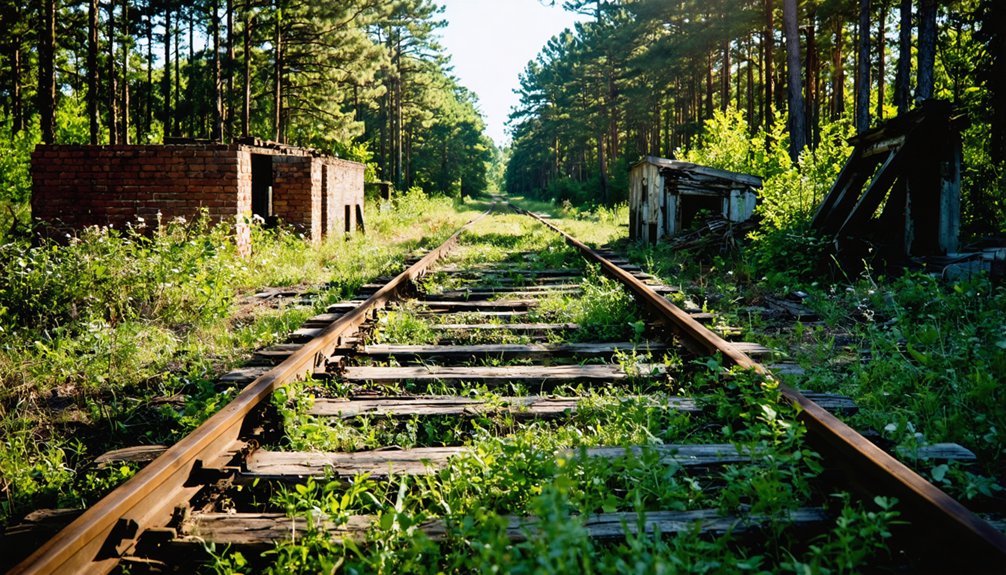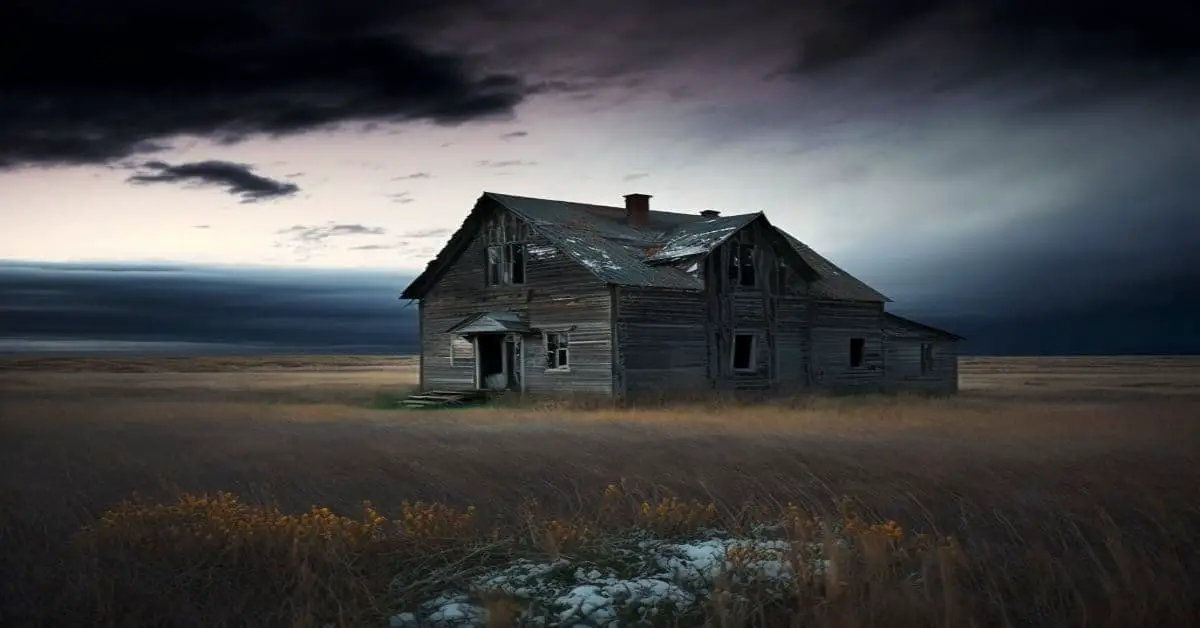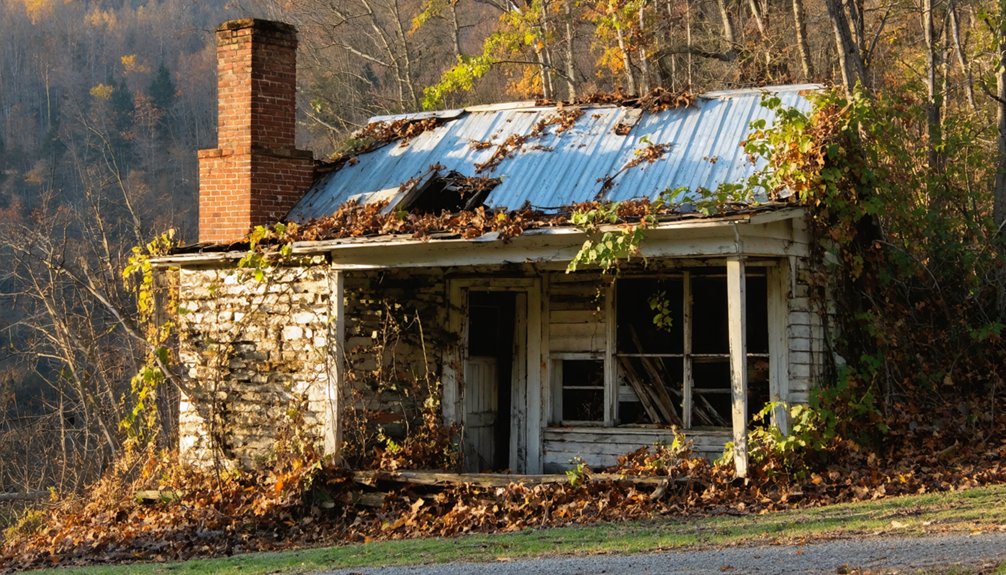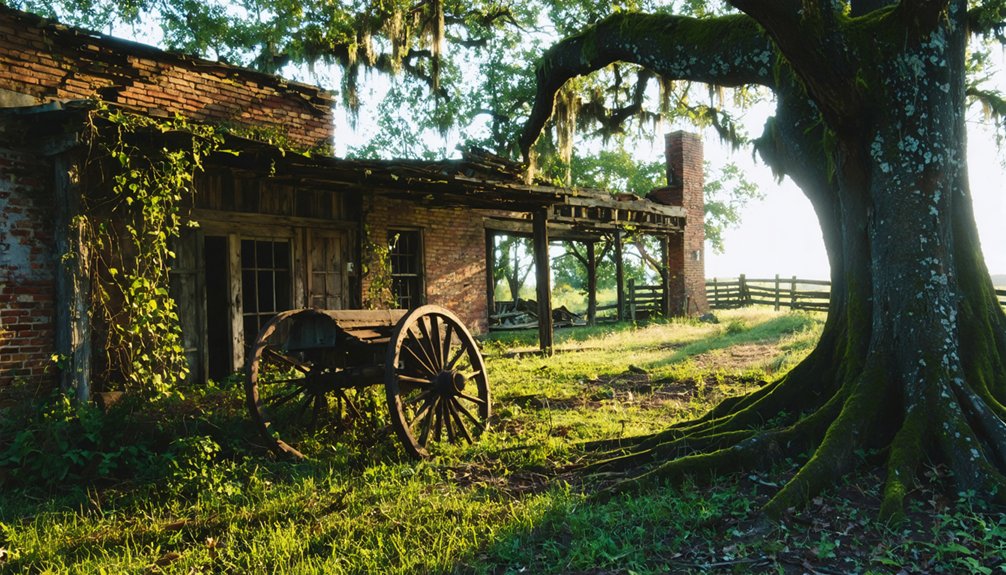You’ll find Graysonia’s ghostly remnants in Clark County, Arkansas, where a once-prosperous lumber town thrived from 1907 to the 1930s. The community boasted impressive daily outputs of 150,000 board feet of timber and supported 1,000 residents with modern amenities like electricity and running water. Today, concrete foundations of the sawmill, commissary, and ice plant peek through the reclaimed forest, while dirt roads lead adventurous explorers to this fascinating slice of Arkansas’s industrial past.
Key Takeaways
- Graysonia was a thriving lumber mill town established in 1907 along the Antoine River in Arkansas, producing 150,000 board feet daily.
- The town peaked with 1,000 residents, featuring company-built houses, schools, a commissary, and modern amenities like electricity and running water.
- Economic decline began in the 1930s due to depleted timber resources, leading to the town’s gradual abandonment over two decades.
- Today, the ghost town is accessible via dirt road between Arkadelphia and Alpine in Clark County, with few remaining structural foundations.
- The site is now heavily forested on International Paper Company land, with only concrete footprints of the sawmill, commissary, and ice plant visible.
A Company Town’s Lumber Legacy
When William Grayson and Nelson McCleod established the Grayson-McLeod Lumber Company in 1907, they laid the foundation for one of the South’s most productive lumber operations.
After relocating from Daleville to the Antoine River’s rich timber resources, they built a thriving enterprise that’d shape Arkansas’s lumber heritage for decades.
You’ll find their company’s influence reflected in Graysonia’s remarkable daily output of 150,000 board feet – six times the regional average.
The lumber giant’s company culture fostered a self-sufficient community of 1,000 residents, complete with modern amenities like electricity and running water.
The town boasted an impressive array of facilities including three hotels, multiple businesses, and a well-equipped school system.
Even after the Bemis family acquired a stake in 1924, renaming it Ozan-Graysonia Lumber Company, the operation maintained its position as a regional powerhouse, supporting over 500 employees through World War I’s demanding production needs.
The town’s prosperity lasted until mill operations ceased in 1932, when the focus shifted to mining cinnabar ore.
Rise to Economic Prosperity
The strategic relocation of Arkadelphia Lumber Company to Graysonia in 1907 marked the beginning of remarkable economic growth for this Arkansas timber town.
You’ll find that World War I catalyzed unprecedented expansion in the lumber industry, transforming Graysonia into a regional powerhouse.
Consider these impressive metrics that showcase the town’s industrial might:
- Daily production soared to 150,000 board feet, six times the output of typical local mills
- Workforce expanded to over 500 employees during peak operations
- Population doubled to 1,000 residents as economic opportunities flourished
The town’s prosperity drove substantial development, including municipal incorporation and extensive infrastructure. The Ozan-Grayson Lumber Company formed in 1924 after acquiring the original business, continuing the town’s industrial legacy. The Clark County location provided strategic advantages for timber harvesting operations.
You’ll appreciate how the Memphis Dallas and Gulf railroad facilitated lumber shipments, while civic amenities like schools, hotels, and entertainment venues served the growing community’s needs.
Daily Life in a Mill Town Community
Life in Graysonia revolved around a meticulously planned community infrastructure designed to support its industrial workforce. You’d find nearly 200 company-built houses equipped with modern amenities like running water and electricity – luxuries rare in rural Arkansas at the time.
Your daily routines would’ve centered around the mill’s 24/7 operations, with community interactions flourishing at the commissary, hillside restaurant, and local cafés. The Ozan-Graysonia Lumber Company emerged when the original Ozan operation merged with Grayson-McLeod in 1915. The West end timber mill was the heart of the town’s economic activity.
After long shifts at the mill, you could’ve relaxed at the pool hall, caught a film at the movie theater, or attended gatherings at the church.
Children received their education at the local school, while the 25-ton ice plant kept your food fresh year-round.
Despite the company’s control, you’d have experienced a degree of autonomy through local government and diverse social venues.
Unique Governance and Infrastructure
Unlike most company towns of the era, you’ll find that Graysonia established itself as a formally incorporated city with elected officials, including its first mayor Nick Peters, despite the Grayson-McLeod Lumber Company owning all land and infrastructure.
You can trace the town’s progressive approach through its early adoption of centralized utilities, including free electricity for residents and a sophisticated water system that served both industrial and residential needs. The town experienced significant growth during World War I with hundreds of workers employed at its large mill.
The unique combination of corporate ownership and municipal governance created an unusual administrative structure where town ordinances and civic management operated alongside company control, setting Graysonia apart from typical mill towns of the period. The town’s lumber mill was one of the region’s largest producers, generating 150,000 board feet of lumber each day at peak operations.
Modern Town Planning
Despite operating as a company-owned settlement, Graysonia distinguished itself through an innovative hybrid governance model that merged corporate control with municipal autonomy. This unique approach to sustainable development created a self-governing community while maintaining industrial efficiency.
The town’s urban revitalization efforts centered on three key planning elements:
- Strategic infrastructure placement, including a 200-house boulevard, industrial facilities, and civic buildings within a precise 640-acre footprint.
- Integration of modern utilities like running water and electricity, uncommon for rural Arkansas at the time.
- Development of community spaces that balanced industrial needs with quality of life, featuring schools, churches, and recreational venues.
You’ll find this planning model represented a progressive departure from typical company towns, demonstrating how corporate interests could align with community autonomy.
Elected Officials Despite Ownership
While most company towns operated under strict corporate control, Graysonia established itself as a rare incorporated city with democratically elected officials, creating a distinctive hybrid governance model.
Under Nick Peters’ leadership as first mayor, you’d find a unique balance between corporate ownership and civic engagement, where elected representation coexisted with Grayson-McLeod Lumber Company’s property control.
The town maintained its own utilities, post office, and municipal services, demonstrating remarkable independence for a company settlement.
You’ll appreciate how this governance structure allowed residents to participate in local decision-making while the company retained land ownership.
Even as the town managed public infrastructure and essential services, the dual authority system preserved both corporate interests and civil municipal functions until Graysonia’s eventual abandonment.
The Slow Fade Into History
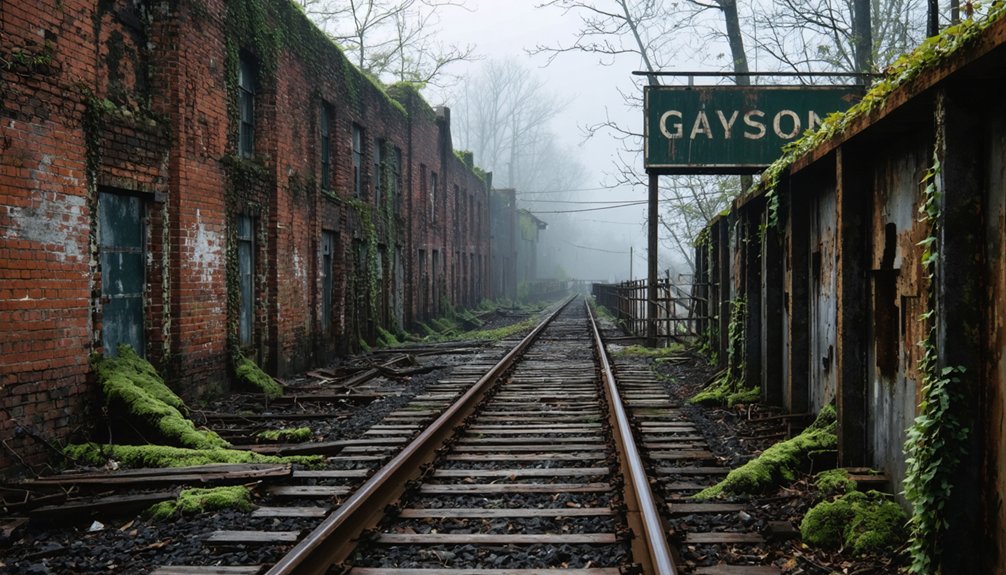
As Graysonia entered the 1930s, the town’s fate became increasingly tied to its dwindling timber resources, setting in motion a gradual dissolution that would span two decades.
You’ll find the economic change wasn’t immediate but rather a steady decline, as residents sought opportunities elsewhere while the town’s identity slowly faded from a bustling mill community into cultural memory.
The final chapter of Graysonia’s story unfolded through:
- A failed attempt at mercury mining that couldn’t replace timber’s economic importance
- The systematic dismantling of buildings, with structures being relocated to Arkadelphia for new purposes
- The post office’s closure in 1950, marking the official end of this once-thriving community
Today, you’ll find only wilderness where this incorporated company town once stood, its legacy preserved primarily in historical records.
Exploring the Ghost Town Today
If you’re planning to visit Graysonia today, you’ll need to navigate a dirt road between Arkadelphia and Alpine in Clark County, Arkansas, with no formal markers or signs to guide you to the exact location.
You’ll find yourself in a remote, heavily forested area where nature has reclaimed most of the former boomtown’s footprint, with few visible remnants of the original structures remaining.
While foundational footings and occasional mill debris can still be discovered beneath the vegetation, the wooden buildings that once formed this thriving lumber community have long since collapsed or disappeared. Like most Arkansas ghost towns, there is little physical evidence remaining of this once-bustling community.
Finding the Site Today
To optimize your exploration, consider these essential preparation steps:
- Plan your visit during daylight hours and dry weather, as dirt roads become challenging after rain.
- Download offline maps, since cell service is unreliable in this remote area.
- Research property boundaries beforehand, as some sections are now gated private property.
While Google Maps still lists Graysonia, you’ll find it’s situated in sparsely populated territory between Arkadelphia and Murfreesboro, requiring careful navigation to reach the site.
What Remains Standing
The modern-day remnants of Graysonia stand in stark contrast to its once-bustling heyday, with only scattered foundations and weathered infrastructure remaining visible through dense vegetation.
Your remnants analysis will reveal concrete footprints where the massive sawmill, commissary, and ice plant once operated. You’ll find these historical preservation sites primarily on land now owned by International Paper Company and leased to deer camps.
As you explore the overgrown terrain, you’ll discover traces of the town’s former glory: crumbling foundation blocks, scattered bits of industrial equipment, and the occasional piece of rail infrastructure.
The once-prominent buildings that housed the theater, hotels, and church have long since vanished, either relocated to Arkadelphia or reclaimed by nature‘s persistent advance.
Frequently Asked Questions
What Happened to William Grayson and How Did He Die?
You’ll find Grayson’s mysterious demise occurred in 1910, though specific details aren’t known. His legacy lived on as his company was renamed Ozan-Graysonia Lumber Company after his death.
Did Any Famous People or Events Originate From Graysonia?
You won’t find any Instagram influencers from this place – records don’t indicate any nationally famous residents or landmark events, though shipping Arkansas’s first cinnabar ore in 1932 was historically significant.
Were There Any Major Accidents or Disasters at the Mill?
You won’t find evidence of major mill accidents in historical records. While other Southern mills faced serious safety issues, Graysonia’s documentation shows no significant disasters or workplace fatalities during its operations.
What Native American Tribes Originally Inhabited the Graysonia Area?
You’d find the Caddo were the primary Native tribe in this region, with historical significance stretching back centuries. The Quapaw and Osage also influenced the area through trade networks.
How Much Did Workers Earn at the Graysonia Lumber Mill?
You’d have earned about 35.9 cents per hour at the lumber mill, bringing in roughly $20.28 for a grueling 56.5-hour workweek under hazardous conditions in 1930.
References
- https://www.ghosttowns.com/states/ar/graysonia.html
- https://arkansashistory.online/2020/06/10/graysonia-clark-county-ghost-town/
- https://en.wikipedia.org/wiki/Graysonia
- https://arkansasfrontier.com/ghost-towns-in-arkansas/303766/
- https://encyclopediaofarkansas.net/entries/ozan-lumber-company-5569/
- https://www.depotmuseum.org/articles.php/article/4
- https://encyclopediaofarkansas.net/entries/graysonia-clark-county-1209/
- https://encyclopediaofarkansas.net/media/graysonia-7279/
- https://ualrexhibits.org/primarysources/primary-source-set/arkansas-geography-economics/
- https://encyclopediaofarkansas.net/media/mill-at-graysonia-7278/
